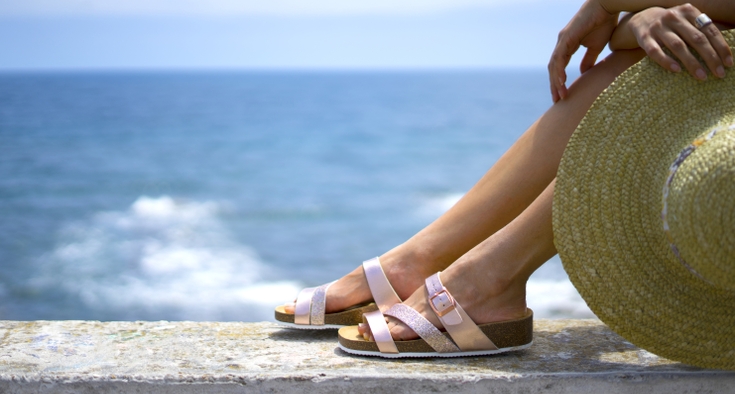Sandal season is here. And if you’ve neglected your tootsies over the winter, it may be time to give them some TLC. Nail fungus can take months – even up to a year – to treat, said Dr. Tara McElroy, a podiatrist with Novant Health Mothershed Foot & Ankle - Winston-Salem.
We sat down with McElroy to find out how to get feet ready for spring and summer.
Don't let foot or ankle pain stop you from your daily life.
How do toenails become thick and discolored?

Most commonly from trauma or a fungal infection. Occasionally, discoloration can be due to reasons other than trauma or fungus, such as staining from nail polish, vitamin deficiencies, psoriasis or any underlying health issues, which a doctor or practitioner would diagnose.
Regarding fungal infections, fungus typically thrives in dark and moist environments. So, keeping your feet dry will help prevent fungal infections. This can include changing your socks if they get sweaty or drying your feet right after you shower. Also, avoid walking barefoot, especially in public places like gym locker rooms or around public pools.
Who can get thick and discolored toenails? Is anyone susceptible?
Anyone can be at risk, but the immunocompromised and people with diabetes are at higher risk. As are those with a genetic predisposition. Thick, hard and discolored toenails are also seen more in the older population.
What can we do to prevent toenail thickening and discoloration?
Wearing appropriately sized shoes that don’t constrict the forefoot can help prevent trauma. If you're taking 10,000 steps a day with your toes hitting the top of your shoe 10,000 times, that’s going to cause trauma after a while. Trauma doesn't have to mean dropping something on your toe; even microtrauma can cause discoloration and thickening.
How do you treat toenail fungus?
There are a lot of options. Over-the-counter remedies include antifungal liquids and nail polishes. There are natural remedies like tea tree oil or a foot soak made with warm water and white vinegar. Some people have success with oregano oil, too. These approaches have the best chance of success if done in the early stages of fungal infection.If you’re not responding to natural or over-the-counter remedies, your doctor may prescribe a topical or oral medication.
How can we prevent foot and nail fungus?
Change your socks. Keep the area between the toes dry, because that area tends to be naturally moist and can harbor fungal infections. There are over-the-counter powders that can help prevent foot fungus.How can we prevent athlete’s foot?
That’s a term used interchangeably with foot fungus. It’s the same thing, although fungus can be more common in athletes due to sweaty moist feet and locker rooms. Try to avoid walking barefoot in public places like gyms, locker rooms or public pools.
Are we more likely to develop foot and nail fungus when it's hot and humid?
If you're wearing constrictive shoes, and your feet are sweating more and you’re not changing your socks, then it can definitely happen more frequently in the summer.
Besides aesthetics, are there other reasons people should address thick, discolored toenails?
Yes. Fungal nails may grow in a disarrayed fashion – what we call nail dystrophy – and that can make you more prone to infected ingrown nails or cause cuts or excessive pressure under the nail, which can cause pain and put you at higher risk for bacterial infections.
I’ve heard that spa pedicures may lead to nail fungus. Is there truth to that?
For the most part, spas that follow proper disinfecting measures are a safe option. The equipment they use should be clean and sterile, but they do reuse a lot of nail polishes. To be on the cautious side, bring your own polish.
You mentioned ingrown nails. What causes those, and how are they treated?
Be careful about how you cut your nails. If you're not cutting straight across – but rounding – that can put you at higher risk for ingrown nails. So can wearing shoes that don't fit appropriately. If they have a narrow toe box and are squishing the toes together, that can put you at higher risk for ingrown nails and other foot issues, like bunions and hammer toes.To treat ingrown toenails, start by soaking your feet in warm water with either Epsom salts or white vinegar or antibacterial soap one to two times a day. Apply an antibiotic cream on the nail borders to help alleviate the ingrowns.
Don’t try digging those nails out yourself; that can cause worsening infection. If you experience continued pain, redness or drainage of the toes, follow up with a doctor or other healthcare provider. You may need antibiotics to treat it or a procedure to remove the ingrown nail.
What procedures are available for ingrown nails?
We perform it in our office, and it’s called a permanent partial matrixectomy. We numb your toe first. Whichever portion of the nail is ingrowing, we cut it all the way back to the nail matrix past the cuticle – which the nail grows out of. Once the nail matrix is exposed and the problematic part of the nail removed, we apply acid, which keeps the nail from growing back in an ingrown fashion.This procedure has an excellent success rate; only about 5% to 10% recur. And it’s relatively quick, and most people go right back to work. Your toe will probably be numb from the numbing medication for a day or so.
Anything else you’d like to share?
People should be aware that treatment for foot fungus – and especially for nail fungus – can take a while to work – three to six months. Even up to a year. If you’re concerned you have either, I would seek treatment early, because it can be a longer-term treatment than a lot of people expect.
It’s very hard to penetrate the keratin (inner layer) of the nail, which makes it harder to eradicate fungus. That, plus nails being slow-growing, makes it hard to treat.












